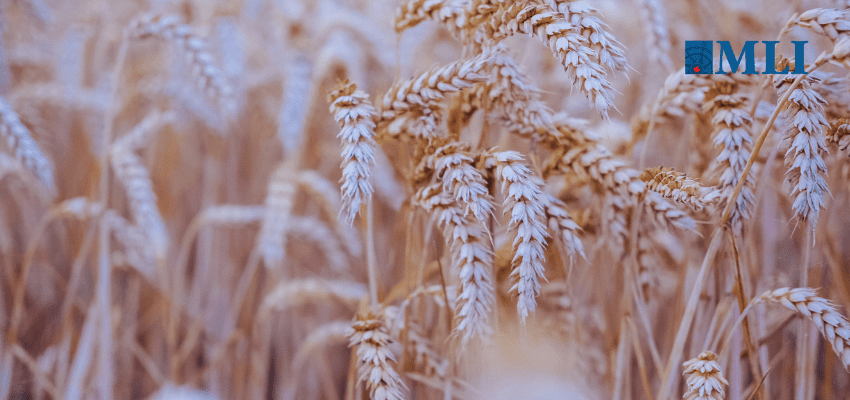This article was adapted from a speech given by Brian Lee Crowley, Managing Director of the Macdonald-Laurier Institute. The event was hosted by the InterAction Council, a group that mobilizes global leaders who have held the highest offices in their countries, on Monday, April 20, 2015, at the University of Ottawa.
By Brian Lee Crowley, June 1, 2015
The amount of food that will be consumed in the next fifty years will exceed all the food eaten in the rest of human history. World demand is on the upswing, driven by rising population, urbanisation and rising global incomes.
Yet the world’s doubtful ability to respond to that growing demand is ringing alarm bells everywhere. After a half century during which the Green Revolution produced a huge spurt in food production, the rate of growth is tailing off just when we most need it to keep rising. If we do not find ways as a planet to rise to this challenge, major food shortages and humanitarian disasters are just a few short years away.
As a result food prices are rising across the world, and those able to feed the world’s teeming billions will not only do a service to humanity, but will make a good living doing so. In agriculture and food, it will be not only possible but imperative to do good by doing well.
By the same token, anything that disrupts food production, especially in agriculturally wellendowed parts of the world, will only make it even more difficult for the world to feed its teeming billions. That makes political and economic turmoil in Russia and Ukraine a serious issue on the food front.
The background
Of the 7 billion people in the world, only about half of them live in cities. But by 2050, according to the UN, the world’s population will have increased by 2.3 billion, whereas the population of the world’s cities will have increased by 2.6 billion. All of the population increase 2 over the next 40 years will take place in cities, and another 300 million people will move from rural areas to the cities.
As Paul Romer, one of the world’s leading economists, said in a talk he gave in Ottawa for my institute, all this means that there is a serious shortage of cities in the world. He points out that much effort is spent trying to tear down the barriers to trade between countries on the grounds that this will increase the world’s wealth by a few percentage points. But you pull more people out of poverty faster by simply moving them from the country to the city. Look no further than this for the explanation of the explosive growth of cities throughout the world and especially in the developing world.
Moreover this rapid urbanisation is the chief explanation as to why these societies are able to grow so quickly compared to the west. We already have gone through the transition; they are on the way.
The effect of urbanisation on workers’ incomes in the developing world is startling. Workers in cities earn 33% more than their nonurban counterparts. Basically, cities make workers more productive.
Not only is urbanization driving rising global prosperity, but rich city dwellers eat differently and usually better than their rural counterparts. Dollar for dollar city-dwellers eat more food and especially more processed foods than their country cousins. They also tend to be richer and able to afford pricier food, such as meat. So meat demand will rise strongly. In 2000, over half (56%) of all the calories consumed in developing countries were provided by cereals and only a fifth (20%) by meat, dairy and vegetable oils. By 2050, the FAO thinks, the contribution of cereals will have dropped to less than half (46%) and that of meat, dairy and fats will have risen to close to a third (29%). To match that soaring demand, meat production will need to increase to 470m tonnes by 2050, almost double its current level. Output of soybeans (most of which are fed to animals) will more than double, to 515m tonnes.
In other words, rising global incomes and population will increase demand for food and change the composition of the average person’s diet, but the entirety of the population increase will take place in cities where these new populations will be unable to supply their own food through their own efforts. Much more food demand will move into the world marketplace. And there will be fewer people in the countryside.
But you cannot simply increase the food supply by flipping a switch. It generally requires secure and robust property rights, land, water, fertilizer, capital and innovation. There is a story to be told on each of those topics, but I am going to have to touch only on a few highlights.
Overall, the FAO reckons, total demand for food will rise about 70% by 2050. But that is still less than half as much as the rise in food production between 1962 and 2006.
It looks more and more likely, however, that increasing food supplies by the 70% we will need in the next 40 years may prove harder than it was to raise them by 150% we managed in the previous 40. The main reason: problems with yields.
Yield—tonnes per hectare, bushels per acre—is the traditional gauge of agriculture’s performance. And the growth in yields has been slowing down, from about 3% a year for staple crops in the 1960s to around 1% now.
The Green Revolution was the reason for the extraordinary growth in productivity in earlier decades. By some estimates, farmers in developing countries could often double their harvest by switching to Green Revolution seeds. Now experts think that the best current technologies could perhaps increase yields by a further 50%—still a lot, but not as spectacular as the earlier improvements. But still 20% shy of what is needed. The low-hanging fruit has been plucked and eaten.
The Green Revolution threw resources at plant-breeding, which worked brilliantly. The new seeds enabled grains to absorb more fertiliser and water. But now there is not a lot more water to spare, and fertiliser usage in some places has already passed saturation point, so a new Green Revolution will have to make even more efficient use of existing resources. The next 40 years will also have to deal with the potentially profound damage to farming from climate change, which in some parts of the world could reduce yields by one-third.
And disturbingly, for the first time since the Green Revolution, crop yields are growing more slowly than population. Between 1961 and 1990 wheat yields were rising at nearly 3% a year. During that period the world’s population was growing, on average, by less than 2% a year. Between 1990 and 2007 population growth slowed down to 1.4%, but the rise in annual wheat yields slackened to 0.5%. The growth in rice yields halved. Improvements in yields of many of mankind’s most important crops, such as corn, wheat and soybeans, are now almost flat; yet consumption is rising. Consumption of corn and soybeans is growing much faster than wheat because corn and soybean meal are fed to animals, soy oil to humans, corn is heavily used for ethanol, and soy competes with rapeseed, which is heavily used in Europe for bio-diesel.
So the changing patterns of food consumption I’ve mentioned mean less of these grains will be consumed directly by people, since it will be going to make meat and other proteins like fish and the conversion ratio of grain to meat is always, as you will know, less than one to one. And grains are also still being drained away for other purposes, such as biofuels.
These trends help to explain rising food prices and declining stocks-to-use ratios, meaning the world food system is more vulnerable to shocks and price volatility, because the buffer stocks on hand are lower. We are leaving an era of food surpluses and entering a world of food shortages with massive implications for humanity and the planet.
The solution isn’t as simple as, say, bringing more agricultural land into production. The adage about land – “they ain’t making any more of it” – is not quite true; several million acres of agricultural land have been cleared in Brazil, for example, in the past two decades and more is available there and elsewhere. Even so, other land is going out of agricultural production in many areas of the world because of urbanization, environmental degradation, and declining water tables. The net result is that, while overall production has been rising, this is not due to an increase in absolute terms in total agricultural land, which is stable.
On the other hand, on a per capita basis, total arable land is declining rapidly.
Another fact about land is its distribution. “The world’s arable land is not distributed around the world in the same proportion as its population.” Asia, for instance, has over half the world’s population but less than 30% of its arable land, for example.
Water, however, and not land, is probably agriculture’s critical limiting factor.
In many areas humanity’s water use is greater than nature’s ability to renew the supply, and agriculture takes about 70% of the water being consumed. As a result, water tables are plummeting. The one in Punjab has fallen from a couple of metres below the surface to, in parts, hundreds of metres down. The rivers that water some of the world’s breadbaskets, such as the Colorado, Murray-Darling and Indus, no longer reach the sea.
By 2030, on most estimates, farmers will need 45% more water. They won’t get it. Cities are the second-largest users of water, and those in the emerging world are growing exponentially. In any dispute between cities and farmers, governments are likely to side with cities.
The reason water matters so much is that irrigated farming is so productive. Only one-fifth of the world’s farmland is irrigated but it contributes two-fifths of the world’s food output.
Water problems will worsen both because irrigated areas will suffer disproportionately from the effects of climate change and because diets are shifting towards meat, which is “thirsty”. It takes 1,150-2,000 litres of water to produce 1kg of wheat, but about 16,000 litres of water for 1kg of beef. As more people eat more meat, rising demand for water by farmers will collide with contracting supplies.
Russia and Ukraine
In this context it is important to note that in recent history mass starvation has almost never been the result of a shortage of food. On the contrary, we have always managed to produce the food necessary to feed the population. On the other hand, food shortages and starvation on a largescale have almost invariably been associated with political instability or the use of food as a weapon in political or ideological struggles.
But the ability of markets to keep people supplied with food is facing the challenges I’ve outlined above. Anything, therefore, that withdraws valuable farmland from production, that prevents the investment needed to plant, grow, move, store and distribute food, or that disrupts existing infrastructure, will be placing an additional burden on an already challenged system.
According to the IICA, Russia and Ukraine are two of the world’s largest producers and exporters of agricultural products; in 2012, they were among the world’s ten main grain exporters. Russia is the fifth largest wheat exporter in the world, while Ukraine is seventh. In the case of corn, Ukraine is the fourth largest exporter and Russia is the ninth. Together, these two countries furnish nearly 13% and 14% of world corn and wheat exports, respectively. Disruption in suppliers of this magnitude can have powerful consequences on international supply.
The richness of the soil, the relatively benign climate and the availability of ample water all make Russia and Ukraine potentially even bigger suppliers of food than they already are, and could make a welcome contribution to staving off the food shortages adumbrated in the earlier section of this paper. Unfortunately the trend is very much in the opposite direction because increased food production requires, as mentioned earlier, secure and robust property rights, land, water, fertilizer, capital and innovation, not to mention reliable and efficient infrastructure. Almost all of these factors are absent or are in decline in Russia and Ukraine.
Observers are reporting that despite its potential, for example, there was little expansion of grain acreage in Ukraine from 2007-12, despite the high prices prevailing at that time. Given today’s low prices and political turmoil, that situation is only likely to get worse. Moreover since the world’s increased food production over the last 50 years came more from raising the productivity of existing farmland rather than expanding acreage, food supply is likely to be far more influenced by our ability to get Russian and Ukrainian land up to international norms of productivity than by expanding the number of acres under cultivation. Here the signs are poor.
Ukrainian farmers are also having a difficult time financing their operations. They can’t use land for collateral because they don’t own the land. Major banks have been leaving the country because of the threat of war. A continued political and military standoff in one of the richest agricultural regions of the world, accompanied by the use of food as a sanctions weapon, is going to put an increasing burden on world food supplies. This is likely to be exacerbated by the fall in energy prices, which together with economic sanctions, will undermine Russia’s ability to make the investments necessary to build the modern infrastructure needed to make it the world food power it could be.
In Russia the confused status of land tenure/ownership and conflicting policy objectives (such as improving the welfare and protecting the civil rights of rural dwellers vs increasing the efficiency of the farming sector) have made it very difficult to attract badly needed capital . Russia plans to invest 600b roubles in food production capacity by 2020iv, but in addition to the confused policies just mentioned, a variety of other factors will also help to make this and other growth targets difficult to achieve. According to the US Congressional Research Service, economic conditions in Russia have deteriorated quickly in recent months. Capital flight has accelerated, the rouble has depreciated by more than 50% (although it has risen slightly in recent months), inflation has increased, and the Russian economy is projected to contract by 3.0% in 2015. The recent politically-motivated interest rate cut by the Russian central bank (to a still very high 14%) underlines the concern of the Russian political class that the country is headed into recession. Sanctions are doubtless partly responsible, but other factors matter as well. In particular, oil prices have fallen by 50% in the past six months, and oil is a major Russian export and source of revenue for the government.
Fertilizer, seed and farm equipment are all more expensive in both Russia and Ukraine at the same time that world prices have softened for most grain, and observers expect a 5%-10% fall in production in the short term, with the investment necessary to raise long-term productivity being pushed ever further out.
Conclusion
In conclusion let me reiterate two observations made earlier: 1) The world’s food supply is becoming ever more vulnerable and the progress needed to feed an additional 2.3 billion people by 2050 will be a huge challenge to human ingenuity; 2) Since the advent of the Industrial Revolution starvation due to actual global shortages of food has been virtually unknown. Where starvation on a large scale has occurred it has been almost exclusively been the intentional policy of governments or the completely foreseeable unintended consequence of other policies (e.g. regarding land tenure). Given the completely understandable revulsion of the international community when faced with Russia’s effort to change recognized international borders by force, sanctions are more than justified. The fact remains, however, that the results of Russia’s invasion of Ukraine and the consequent international sanctions are that the rest of the world food supply will have to bear the additional burden of a politically-caused decline in this vital region’s contribution to meeting the world’s rising need for food.
Thank you.
Brian Lee Crowley is the managing director of the Macdonald-Laurier Institute.





